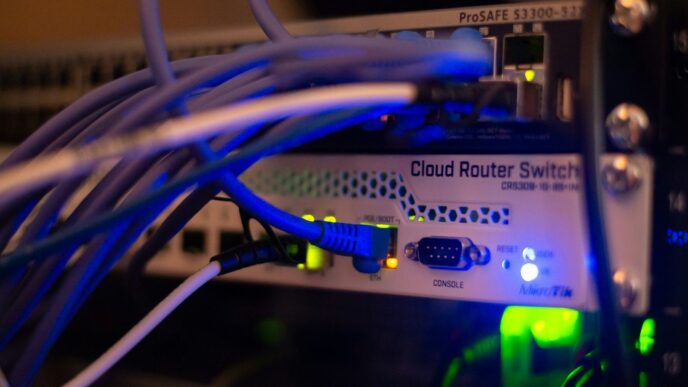So, you’re trying to get a handle on Singapore’s data protection rules, huh? It’s called the Personal Data Protection Act, or PDPA for short. It’s basically the law that says how companies have to handle your personal info. Think of it like a set of rules for keeping your data safe and sound. We’ll break down what you need to know to stay on the right side of the law, whether you’re a business owner or just curious about your own privacy. It might seem a bit much at first, but once you get the basics, it’s not so scary.
Key Takeaways
- Understand the core rules of the Personal Data Protection Act Singapore, including how it started and what principles guide data use.
- Know the main things businesses must do, like getting permission to use data, only using it for the stated reason, and keeping it accurate and secure.
- Figure out the rules for sending data outside of Singapore, making sure it’s still protected.
- Be ready to report data breaches quickly to the authorities and the people affected.
- Set up good internal systems, maybe appoint a data protection officer, and have clear policies to show you’re following the law.
Understanding the Personal Data Protection Act Singapore
So, let’s talk about Singapore’s Personal Data Protection Act, or PDPA for short. It’s basically the law that sets the rules for how companies can collect, use, and share your personal information. Think of it as the rulebook for keeping your data safe and sound.
History and Evolution of the PDPA
The PDPA first came into effect back in 2012. It was a big step for Singapore, putting in place a clear framework for data protection. Over the years, it’s seen some updates, most notably in 2020, to keep up with how technology and data handling have changed. These amendments brought in things like mandatory data breach notifications, which are pretty important.
Core Principles Governing Data Use
At its heart, the PDPA is built on a few key ideas. These aren’t just suggestions; they’re the main principles that organizations have to follow:
- Consent: Generally, companies need your permission before they can collect, use, or share your personal data. This consent needs to be clear and informed.
- Purpose Limitation: They can only collect your data for specific reasons that they tell you about. They can’t just collect it and then decide to use it for something else later without your okay.
- Data Accuracy: Companies have to make a reasonable effort to make sure the personal data they have on you is correct and up-to-date.
- Security: This is a big one. Organizations must put in place sensible security measures to protect your data from being accessed by unauthorized people or from getting leaked.
- Retention Limitation: They shouldn’t keep your personal data longer than they actually need it for the stated purpose.
- Accountability: Companies need to be able to show that they are actually following these rules. This often means appointing someone to be in charge of data protection.
Scope and Applicability to Businesses
Who does the PDPA apply to? Pretty much any business that handles personal data in Singapore. It doesn’t matter if you’re a small startup or a huge multinational corporation; if you’re collecting, using, or disclosing personal data here, you need to comply. This applies across all industries, so there’s no escaping it. Essentially, if you’re doing business in Singapore and dealing with people’s personal information, you’re under the PDPA’s watch. It’s not just about avoiding fines; it’s also about building trust with your customers and stakeholders.
Key Compliance Obligations Under the PDPA
So, you’re dealing with personal data in Singapore? The Personal Data Protection Act (PDPA) lays down some pretty clear rules you need to follow. It’s not just about avoiding fines, though that’s a big part of it; it’s also about making sure people trust you with their information. Let’s break down what you absolutely need to get right.
Consent and Notification Requirements
This is where it all starts. Before you even think about collecting someone’s personal data, you need to get their okay. And not just a vague nod. Consent must be explicit, informed, and freely given. This means you have to tell people exactly why you need their data, what you’ll do with it, and who you might share it with. It’s like asking permission before borrowing something – you wouldn’t just grab it, right? You also need to make sure this notification happens right when you’re collecting the data. No hiding it in tiny print later on.
Purpose Limitation and Data Accuracy
Once you have consent, you can’t just use the data for whatever you want. The PDPA says you can only use it for the specific, legitimate reasons you told the person about. If you collected someone’s email for a newsletter, you can’t then sell that email to a third party without getting new consent. It’s all about sticking to the plan you agreed on. On top of that, you have to make a reasonable effort to keep the data accurate and complete. If you have someone’s old address, you should try to update it if you find out their new one. It’s about treating the data with a bit of care.
Security and Retention Limitations
Keeping data safe is a big deal. You need to put in place sensible security measures to stop unauthorized access, accidental loss, or any other nasty surprises. Think of it like locking your doors and windows – you’re taking steps to protect what’s inside. And just as important, you can’t hold onto personal data forever. You should only keep it for as long as you need it for the original purpose. Once that purpose is done, you need to get rid of it properly. Holding onto old data unnecessarily just increases your risk.
Navigating Cross-Border Data Transfers
So, you’ve got data, and it needs to go places, right? Maybe it’s customer info heading to a cloud service in another country, or perhaps you’re working with a partner overseas. When that data leaves Singapore, the Personal Data Protection Act (PDPA) has some specific rules you need to follow. It’s not just about sending data off into the ether; you have to make sure it’s still protected.
PDPA Standards for International Transfers
Basically, when you send personal data outside of Singapore, you’ve got to make sure the place it’s going offers a similar level of protection. Think of it like sending a valuable package – you wouldn’t just toss it in any old mailbox. The PDPA expects you to take reasonable steps to see that the data remains safe and sound, even when it’s not physically in Singapore. This means you can’t just assume everything is fine; you need to actively check.
- Assess the destination: Does the country where the data is going have its own strong data protection laws? If not, what safeguards are in place?
- Contractual clauses: Often, you’ll use agreements with the receiving party that spell out exactly how they must protect the data. These are like the terms and conditions for your data’s journey.
- Consent: In some cases, you might need to get explicit consent from the individuals whose data you’re transferring internationally. They should know where their data is headed.
Risk Assessment for Recipient Countries
Before you pack up your data and ship it out, you really should do a bit of homework on the recipient country. This isn’t just a suggestion; it’s part of your responsibility under the PDPA. You need to figure out if that country’s privacy laws are up to snuff compared to Singapore’s. If a country has weak protections, or if there’s a high chance the data could be accessed by foreign governments without proper legal process, that’s a red flag.
- Research local laws: Look into the data protection landscape of the country receiving the data. Are there specific laws that might conflict with PDPA principles?
- Consider data type: Is the data sensitive? The more sensitive it is, the more careful you need to be about where it goes.
- Document your findings: Keep records of your assessments. If something goes wrong later, you’ll want to show you did your due diligence.
Implementing Safeguards for Data Movement
Once you’ve assessed the risks, it’s time to put some protective measures in place. This is where you build the actual security around your data transfers. It’s not a one-size-fits-all situation, and what works for one transfer might not work for another. The goal is to create a robust system that minimizes the chances of data misuse or unauthorized access.
- Encryption: Make sure data is encrypted both when it’s being sent (in transit) and when it’s stored (at rest) in the new location.
- Access controls: Limit who can access the data in the receiving country. Only give access to those who absolutely need it for their job.
- Data minimization: Only transfer the data that is strictly necessary for the intended purpose. Don’t send more than you need.
- Regular reviews: Periodically check if your safeguards are still effective and if the recipient country’s situation has changed.
Addressing Data Breach Notification Mandates
So, you’ve got personal data, and you’re doing your best to keep it safe. But what happens when, despite your best efforts, a data breach occurs? The Personal Data Protection Act (PDPA) in Singapore has specific rules about this, and ignoring them can lead to some serious trouble.
Timely Reporting to Authorities and Individuals
This is a big one. If a data breach happens and it’s likely to cause significant harm to individuals, you can’t just sweep it under the rug. You’ve got to let the Personal Data Protection Commission (PDPC) know, and you also need to inform the people whose data was affected. The clock starts ticking pretty much immediately after you become aware of the breach. There isn’t a lot of wiggle room on the timeline, so having a plan in place before anything happens is really important. This notification requirement is a key part of the PDPA, aiming to keep individuals informed and allow them to take protective steps. You can find more details on the PDPC’s role in managing these situations.
Mitigating Factors in Breach Investigations
When a breach does occur, it’s not just about reporting it. You need to figure out what happened, how bad it is, and what you’re going to do about it. This involves a thorough investigation. Were your security measures up to par before the breach? Did you act quickly to stop the breach from getting worse? Did you take steps to lessen the harm to those affected? These are the kinds of things that will be looked at. It’s about showing you’re taking responsibility and trying to fix the situation. Think of it like this:
- Assess the scope: How many people and how much data are involved?
- Identify the cause: What exactly went wrong?
- Contain the damage: Stop the breach from spreading or continuing.
- Remediate: Fix the vulnerability that allowed the breach.
- Communicate: Inform the relevant parties as required.
Consequences of Non-Compliance
Let’s be blunt: not following the data breach notification rules can get expensive. We’re not just talking about a slap on the wrist. Fines can be substantial, potentially reaching up to 10% of a company’s annual turnover in Singapore or a flat SGD 1 million, whichever is higher, depending on the severity. Beyond the financial hit, there’s the reputational damage. Trust is hard to build and easy to lose. If customers feel their data isn’t safe with you, they’ll likely take their business elsewhere. This can really impact your bottom line and make it harder to attract new customers or even investors down the line.
Accountability and Governance Frameworks
Building a solid accountability and governance framework is pretty much the backbone of PDPA compliance. It’s not just about ticking boxes; it’s about creating a system where data protection is woven into how your business operates every single day. This means having clear structures and processes in place to manage personal data responsibly.
Appointing a Data Protection Officer
One of the first big steps is designating a Data Protection Officer (DPO). This person is your go-to for all things PDPA. They don’t necessarily need to be a legal expert, but they should have a good grasp of data protection laws and your organization’s data handling practices. Think of them as the internal champion for privacy.
- Responsibilities often include:
- Advising on PDPA obligations.
- Monitoring compliance with policies and the Act.
- Acting as the point of contact for individuals and the authorities.
- Training staff on data protection.
Developing Written Data Protection Policies
Having a DPO is great, but they need something to work with. That’s where written data protection policies come in. These documents outline how your organization collects, uses, discloses, and protects personal data. They should be clear, accessible, and regularly reviewed. These policies serve as a roadmap for your staff and a demonstration of your commitment to compliance. They should cover:
- Consent and Notification: How you obtain consent and inform individuals about data use.
- Purpose Limitation: How you ensure data is only used for specified purposes.
- Data Accuracy: Steps taken to keep personal data correct and up-to-date.
- Security Safeguards: Measures to protect data from unauthorized access or loss.
- Retention Limits: How long data is kept and how it’s disposed of.
- Cross-Border Transfers: Rules for sending data outside of Singapore.
Demonstrating Compliance Through Audits
Policies and procedures are one thing, but how do you know they’re actually working? Regular audits are key. These internal or external reviews check if your practices align with your policies and the PDPA requirements. They help identify gaps before they become problems. Think of it like a health check for your data protection program. An audit might look at:
- Record Keeping: Are consent records properly maintained?
- Access Logs: Who has accessed sensitive data, and when?
- Security Measures: Are firewalls and encryption up-to-date?
- Training Records: Has staff completed the required data protection training?
By having these three elements – a designated DPO, clear written policies, and regular audits – you build a strong foundation for accountability and governance under the PDPA.
AI Governance and Data Protection
Artificial intelligence is changing how businesses operate, and Singapore’s Personal Data Protection Act (PDPA) has specific considerations for its use. It’s not just about collecting data anymore; it’s about how that data fuels AI systems responsibly. The PDPA, alongside guidance like Singapore’s Model AI Governance Framework, aims to ensure AI development and deployment are transparent and accountable.
Transparency in AI System Usage
When you’re using AI, especially systems that make decisions affecting individuals, you need to be upfront about it. People have a right to know if an AI is involved in processes like loan applications or hiring. This means clearly communicating when and how AI is being used. It’s about building trust, not hiding behind complex algorithms. Think about it: if an AI denies your application, wouldn’t you want to know why? Transparency helps answer that.
Leveraging Legitimate Interests for AI
Sometimes, getting explicit consent for every single data point used in AI training can be a hurdle. The PDPA offers an exception for using personal data under ‘legitimate interests,’ but this comes with strict conditions. You can’t just process data because you feel like it. The processing must be for a legitimate purpose, not override individual interests, and be reasonably expected by the individual. For example, using anonymized customer data to improve a service might fall under this, but using it to target ads without any prior indication probably wouldn’t. It’s a careful balancing act. You can find more details on PDPA standards for international transfers.
Enhanced Governance for AI Deployment
Deploying AI isn’t a one-off event; it’s an ongoing process that needs oversight. This involves more than just having a Data Protection Officer (DPO), though that’s a big part of it. You need to think about:
- Risk Assessments: Before deploying an AI system, assess the potential privacy risks. What could go wrong? How could data be misused?
- Data Lifecycle Management: Track how data is collected, used, stored, and eventually deleted within the AI system.
- Regular Audits: Periodically check that the AI system and its data handling practices still comply with the PDPA and your own policies.
- Model Updates: When you update an AI model, re-evaluate its data protection implications. Changes can introduce new risks.
This structured approach helps manage the complexities that come with AI, making sure you’re not just innovating, but doing so safely and legally.
Mitigating Risks and Enhancing Trust
Look, nobody wants to deal with fines or have their company’s name dragged through the mud. It’s just bad for business, plain and simple. When you mess up with personal data, the consequences can hit hard, both in your wallet and with your customers. We’re talking about significant financial penalties, sometimes a big chunk of your yearly earnings, and that’s before we even get into the damage to your reputation. People just stop trusting you, and that’s tough to win back.
Think about it: customers are way more aware these days about their data rights. They want to know their information is safe. If a company has a data breach or is seen mishandling data, that trust just evaporates. It can really hurt customer loyalty and make it harder to build new relationships. Getting PDPA compliance right isn’t just about following rules; it’s about building a solid foundation of trust.
So, what can you actually do about it? It’s not as complicated as it sounds, but it does take some effort.
- Know Your Data: First off, you need to really understand what personal data you’re collecting, where it’s stored, how it moves around, and who can access it. Think of it like taking inventory of your digital assets. This is a big part of PDPA compliance in Singapore.
- Assess Your Risks: Regularly check for weak spots, especially when you’re moving data across borders or using new tech like AI. Document these assessments so you have proof of your due diligence.
- Keep Policies Current: Make sure your internal policies and any agreements you have with other companies (like Data Processing Agreements) are up-to-date and reflect the latest requirements.
By taking these steps, you’re not just avoiding trouble. You’re actually showing your customers and partners that you take their privacy seriously. This can turn a potential problem into a real advantage. When people trust you, they’re more likely to stick with you, and that’s good for long-term growth. It’s about being responsible and, in the process, making your business stronger.
Wrapping Up: Staying Compliant with PDPA
So, we’ve gone over a lot about Singapore’s Personal Data Protection Act. It’s definitely not a simple topic, and keeping up with it can feel like a lot. But remember, it’s really about building trust with people whose data you handle. By focusing on getting consent, being clear about why you need data, and keeping it safe, you’re already on the right track. It might seem like extra work now, but honestly, avoiding big fines and keeping your customers happy is totally worth it in the long run. Think of it as part of doing good business, not just a legal hurdle.
Frequently Asked Questions
What is the PDPA and why is it important for businesses in Singapore?
The PDPA, or Personal Data Protection Act, is a law in Singapore that sets rules for how businesses can collect, use, and share people’s private information. It’s super important because following these rules helps businesses keep customer information safe, avoid big fines, and build trust with people they do business with. Think of it as a guide to being a good digital citizen.
Do I need permission to collect someone’s personal data?
Yes, generally you do! The PDPA says you need to get clear permission, called ‘consent,’ from a person before you can collect, use, or share their personal details. This permission needs to be given freely and the person should know exactly what you’ll do with their information.
Can I use someone’s data for any reason I want after I collect it?
Nope, you can’t just use data however you please. The PDPA has a rule called ‘purpose limitation.’ This means you can only use the data for the specific, good reasons you told the person about when you collected it. You can’t suddenly decide to use it for something else without their okay.
What happens if my company has a data breach?
If your company has a serious data leak or hack, you have to let the authorities know right away. You also need to tell the people whose information might have been exposed. Not doing this on time can lead to big trouble, like hefty fines and a damaged reputation.
Do I need to appoint someone to be in charge of data protection?
Yes, most businesses need to assign someone to be a Data Protection Officer, or DPO. This person is responsible for making sure the company follows all the PDPA rules. They help create policies and make sure everyone in the company understands how to handle personal data correctly.
Can I send personal data outside of Singapore?
You can send personal data outside Singapore, but you have to be careful. The PDPA requires that the data still gets protected well, even in another country. You need to check if the country you’re sending it to has good enough data protection rules, or put extra safety measures in place.














